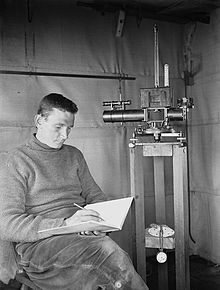George Clarke Simpson

Sir George Clarke Simpson KCB CBE FRS (born September 2, 1878 in Derby , † January 1, 1965 in Bristol ) was a British meteorologist .
Life
George Clarke Simpson was born in Derby to Alice Lambton Clarke and Arthur Simpson, owners of a department store on East Street. He attends the Derby School , Owens College in Manchester and the University of Göttingen .
After completing his training, he visited Lapland in 1902 to investigate electrical phenomena in the earth's atmosphere, then known as air electricity . In 1905 he became a lecturer at the University of Manchester , making him the first to give a lecture in meteorology at a British university.
In 1906 he was employed by the India Meteorological Department as an Imperial Meteorologist at what was then the headquarters in Shimla . His duties included inspections of meteorological stations in India and Burma .
In 1910 he and his colleague Charles Seymour Wright became a meteorologist on Robert Falcon Scott's Antarctic Terra Nova expedition . During the expedition he set up one of the first weather stations on the Antarctic continent. He carried out experiments with balloons to study the atmosphere and the altitude dependence of temperature. Simpson kept records of temperature and wind observations at the base station on Cape Evans . During Scott's trip to the South Pole, he was in command of the station for several months from November 1911.
After his return from Antarctica in August 1912, he returned to the Indian Meteorological Service in Simla, where, after the headquarters had moved to Calcutta, a branch was now located. In Simla, Simpson lived in the Khud Cottage, now also known as Madan Kunj . Simpson was gathering his notes from the expedition at Khud Cottage. During the occupation of Burma by Japan in World War II, Khud Cottage was the temporary residence of the British Governor of Burma.
With the outbreak of World War I, Simpson, like many other officers in the Indian Meteorologist Department, was drafted into military service. From March to May 1916 he was meteorological advisor to the British expeditionary forces in Mesopotamia in what is now southern Iraq. He was later recalled from Simla and served as Assistant Secretary of the Board of Munitions .
In 1920 he was appointed director of the Met Office in London, where he remained until his retirement in 1938, becoming the director with the longest tenure. During his tenure as director, he conducted research on electricity, ionization , radioactivity and solar radiation in the earth's atmosphere. He researched the causes of lightning . In 1926 he was involved in the agreement on the Vienna scale for calculating the Beaufort scale with a wind force scale named after him and based on a work from 1905/1906, a modification of the Beaufort scale . Simpson's calculation method is still the basis of the Beaufort scale today.
In 1935 he was knighted.
With the start of World War II, Simpson was called back from retirement to active duty and took over the management of the Kew Observatory . There he continued his studies on electrical structures in thunderstorms until 1947.
Simpson died in 1965 at the age of 86.
Since September 23, 1914 he was married to Dorothy Jane Stephen. The couple had four children: Scott (1915–1981), Professor of Geology at the University of Exeter , Arthur, Oliver and Jean Simpson.
honors and awards
- Honorary doctorates from the University of Manchester , the University of Sydney and the University of Aberdeen
- Fellow of the Royal Society , 1915
- Commander of the Order of the British Empire , 1919
- Companion of the Order of the Bath , 1926
- Knight Commander of the Order of the Bath, 1935
- President of the Royal Meteorological Society , 1940–1942
- 1946 Honorary Fellow of the Royal Society of Edinburgh
- The building for observing ice and climate of the British Antarctic Survey on the Halley Station , Antarctica (75 ° 35'S, 26 ° 40'W) is in memory of Simpson The Simpson Platform called.
- In Antarctica, the Simpson Glacier , Simpson Peak and Simpson Head are named after him.
Web links
Individual evidence
- ^ A b E. Gold: George Clarke Simpson 1878-1965. In: Biographical Memoirs of Fellows of the Royal Society , 11, 1965, pp. 165–175 (PDF; 3.4 MB). Retrieved July 20, 2018.
- ^ Gordon Manley: George Clarke Simpson, 1878-1965. In: Journal of Glaciology , 5 (42), 1965, pp. 873-874 (PDF; 1.6 MB). Retrieved July 20, 2018.
- ^ Fellows Directory. Biographical Index: Former RSE Fellows 1783–2002. (PDF file) Royal Society of Edinburgh, accessed April 7, 2020 .
| personal data | |
|---|---|
| SURNAME | Simpson, George Clarke |
| BRIEF DESCRIPTION | British meteorologist |
| DATE OF BIRTH | September 2, 1878 |
| PLACE OF BIRTH | Derby |
| DATE OF DEATH | January 1, 1965 |
| Place of death | Bristol |
